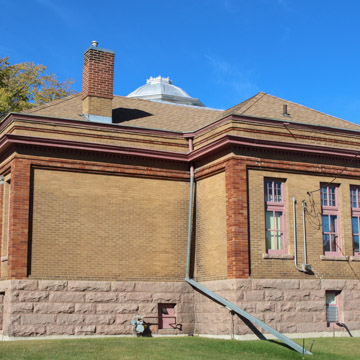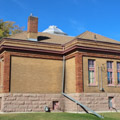You are here
Grant County Historical Museum
The Milbank Carnegie Library replaced an earlier library that opened in 1882, two years after the northeastern South Dakota town of Milbank was founded. The new library was funded in 1905 with a grant from Andrew Carnegie; it was one of 25 Carnegie libraries built in the state.
Minneapolis architect Ralph D. Church designed the Classical Revival structure, which is clad in two-tone brick and rests on a raised basement foundation of rock-faced ashlar. Its L-shaped plan, though not unusual in Carnegie library architecture nationwide, was unique among South Dakota examples of the building type. The main entrance, tucked into the recessed corner of the L and reached by a flight of stairs on either side, faces the intersection of its downtown corner lot. The intersecting hipped roof is crowned with a polygonal dome, which serves to light the interior space of the main floor. Classical detailing includes the dentils beneath the cornice, unfluted Doric columns, and pilasters with an egg-and-dart pattern in the capitals.
This building served as a library until 1979, when the new Grant County Library opened a few blocks south near the courthouse. In 1982, the Carnegie Library became home to the Grant County Historical Society, which has since operated the building as a museum displaying county artifacts.
References
Writing Credits
If SAH Archipedia has been useful to you, please consider supporting it.
SAH Archipedia tells the story of the United States through its buildings, landscapes, and cities. This freely available resource empowers the public with authoritative knowledge that deepens their understanding and appreciation of the built environment. But the Society of Architectural Historians, which created SAH Archipedia with University of Virginia Press, needs your support to maintain the high-caliber research, writing, photography, cartography, editing, design, and programming that make SAH Archipedia a trusted online resource available to all who value the history of place, heritage tourism, and learning.




